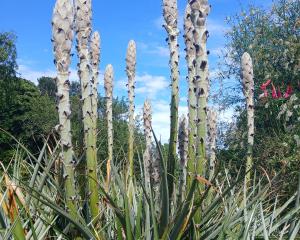Rose judge Val Clarke gives Gillian Vine some timely tips on showing.
Roses are reaching their peak and there is no better place to see them than at shows, as gardeners exhibit the pick of their blooms.
But what makes a good show rose?
I confess my ignorance to judge Val Clarke, of Weston, who begins by explaining the main classifications.
The first, where the flower is only a quarter to half open, is referred to as decorative.
From there to three-quarters open is deemed an exhibition bloom and fully open is more than three-quarters.
Combining the three stages in a separate class always looks good and the trick to success, Val says, is to grow hybrid tea roses, like Paddy Stephens and Elina, whose bushes produce blooms in succession.
That is vital because each ''three-stagers'' entry has to be of the same variety.
Incidentally, because hybrid teas generally have one multi-petalled flower on a long stem, they dominate most sections of a rose show.
Many of the floribunda roses come into their own in the stem classes, as they tend to produce good heads with a bunched effect.
The small stem class is not, as might be imagined, for miniature roses but for a single stem with up to three open flowers, while a large stem has four or more.
A little planning can help improve the chances of success in the stem classes Val says, demonstrating her point with a McGredy rose, Old Master.
One flower has opened but looks crushed by its surrounding green buds.
Careful removal of the central flower at bud stage would enable the others to develop and increase the likelihood of a prize card.
Miniature roses, which are shown in their own section, can also be enhanced by judicious removal of excess buds.
Val takes one ''judges would consider too busy'' and with fine scissors takes out nine or 10 buds.
It's difficult to see where they were but the result is much more attractive than the unpruned stem.
All roses are shown with their leaves so, when trimming, it is important to leave the foliage, even if damaged, so it complements the bloom.
Many an otherwise fine rose has lost points because of a bare stem and although some experienced exhibitors trim damage with nail scissors, it is a bit risky for novices.
With special novice classes you'll be in good company, so it is probably better to leave well alone.
Where there are three roses in a vase, the foliage of one can sometimes be arranged to cover the barer stem of another, but this requires careful manipulation to avoid damage.
Single roses, which have just five petals, may be entered in stem classes but, in general, are rarely suitable for the show bench.
For new exhibitors, most rose shows offer the option of classes which require a rose with little or no stem either floating in a bowl or displayed in a Porta Frame.
Like vases, bowls and frames are supplied by clubs.
Regardless of which classes you plan to enter, Val recommends picking roses the day before a show and standing them in a cool place in a bucket of water overnight.
This should ensure they last well during a two-day show.
So, if you love roses, why not share your enthusiasm with others and enter a show?
Five to show
For those new to showing roses, Val Clarke recommends five hybrid tea varieties that are suitable for exhibition as well as the home garden.
Cream Elina and pink Paddy Stephens can be shown as single stems and are good ''three-stagers''.
Others to start with are Solitaire, with soft yellow petals edged with pink; Auckland Metro, whose almost white petals have a hint of peach in the centre; and medium red Loving Memory.
See them
The Otago Rose Society's annual show is being held this weekend at Forbury Park Raceway, Victoria Rd, St Kilda, Dunedin. It is open to the public from 1.30pm-5pm tomorrow and 10am to 3.30pm on Sunday. There will be displays by several groups, plant sales, raffles, refreshments and a rose identification service and advice. Admission is $5 which includes afternoon tea; ORS members and children free.
The North Otago Rose Society's annual show is being held on Friday, December 6 and Saturday, December 7 at the Oamaru Pipe Band Hall (adjacent to the hospital car park). The show is open to the public without charge from 1pm-6pm on Friday and 10am-4pm on Saturday. It is free to enter roses and schedules are available from Christine Schaffer, phone (03) 434-2223. Alternatively, take entries to the hall between 7pm and 9pm on Thursday, December 5, and society members will assist with classification and staging.












